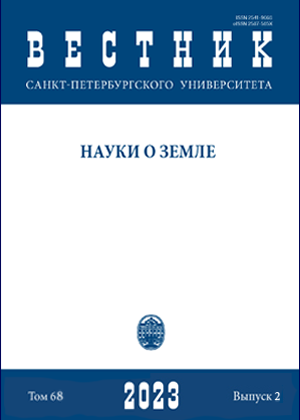Kaalamo and Velimyaki paleoroterozoic gabbroid massifs of the Northern Ladoga area: thermodynamic modeling of crystallization and evolution trends of igneous rocks
DOI:
https://doi.org/10.21638/spbu07.2023.204Abstract
Kaalamo and Velimyaki gabbroid massifs are located in the south-eastern part of the Raahe-Ladoga suture zone of the Karelian craton and the Sveсofennian mobile belt. These massifs were formed almost simultaneously 1.89 Ga ago, occupy the same tectonic position and are located in a single unit of the Early Proterozoic metamorphosed rocks: the intrusions are contained by the Early Proterozoic supracrustal stratas: garnet-biotite gneisses and micaceous shales of the Ladoga series, as well as amphibolites of the Sortavala series. Despite this, the gabbroids of the compared massifs differ sharply in their material composition, especially the content of alkalis in a differentiated series of rocks. The results of thermodynamic modeling of magmatic crystallization (Magma Chamber Simulator, MELTS packages) showed that a differentiated sub-alkaline series of rocks of the Velimyaki massif cannot be obtained from magma of the Kaalamo massif by slightly changing such parameters as pressure, water content in the melt, and oxygen fugacity. The assumption of a significant difference in these parameters for magmas of the Kaalamo and Velimyaki massifs is not confirmed at the mineralogical-petrographic level and other characteristics of the rocks of the compared ones. The effect of contamination at the level of the magma chamber also does not significantly shift the trend of rock compositions from the calc-alkaline region to the sub-alkaline region. Analysis of the results of thermodynamic modeling of magmatic mineral formation in the two massifs allows us to make it possible to conclude that the Kaalamo and Velimyaki massifs were formed either from various parent melts, or their initial melt was one, but the magma of the Velimyaki massif underwent contamination with enrichment with alkalis along the migration route of magma until the level of the upper crust was reached.
Keywords:
paleoproterozoic, Svecofennian belt, gabbroids, thermodynamic modeling, MCS, MELTS
Downloads
References
Downloads
Published
How to Cite
Issue
Section
License
Articles of "Vestnik of Saint Petersburg University. Earth Sciences" are open access distributed under the terms of the License Agreement with Saint Petersburg State University, which permits to the authors unrestricted distribution and self-archiving free of charge.






